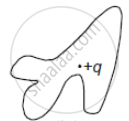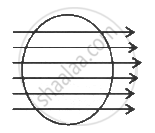Advertisements
Advertisements
Questions
Define electric flux.
Define electric flux. Is it a scalar or a vector quantity?
Solution 1
Electric flux is the total number of lines of force passing through the unit area of a surface held perpendicularly.
Electric flux ΔΦ through an area element ΔS is given by
ΔΦ = E.ΔS = EΔScosθ
θ is the angle between E and ΔS.
Solution 2
Electric flux is defined as the number of electric field lines crossing the per unit area. It is given as
`triangle phi = vecE.vec(triangleS) cos theta`
where `vecE` is Electric field and `vec(triangleS)`is area vector. The angle θ here is the angle between `vecE` and `vec(triangle S)`.
Since Electric flux is the dot product of two vectors, Hence it is a Scalar quantity.
APPEARS IN
RELATED QUESTIONS
Consider a uniform electric field E = 3 × 103 `bbhat i` N/C.
- What is the flux of this field through a square of 10 cm on a side whose plane is parallel to the yz plane?
- What is the flux through the same square if the normal to its plane makes a 60° angle with the x-axis?
What is the net flux of the uniform electric field of previous question through a cube of side 20 cm oriented so that its faces are parallel to the coordinate planes?
Two charges of magnitudes −2Q and +Q are located at points (a, 0) and (4a, 0) respectively. What is the electric flux due to these charges through a sphere of radius ‘3a’ with its centre at the origin?
The electric flux through the surface ______.
 |
 |
 |
 |
| (i) | (ii) | (iii) | (iv) |
The SI unit of electric flux is ______.
An electric charge q is placed at the centre of a cube of side a. The electric flux on one of its faces will be ______.
If the electric flux entering and leaving an enclosed surface respectively is Φ1 and Φ2, the electric charge inside the surface will be
A circular disc of radius 'r' is placed along the plane of paper. A uniform electric field `vec"E"` is also present in the plane of paper. What amount of electric flux is associated with it?

A hollow sphere of radius R has a point charge q at its centre. Electric flux emanating from the sphere is X. How will the electric flux change, if at all, when radius of the sphere is doubled?
